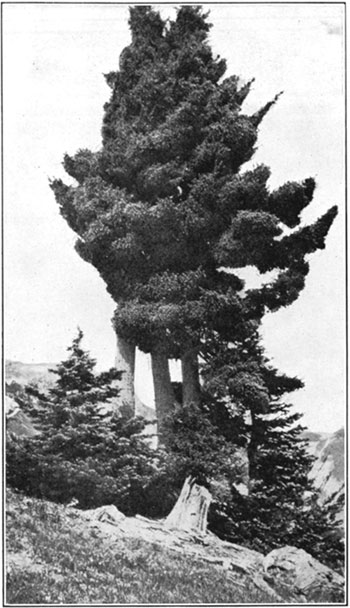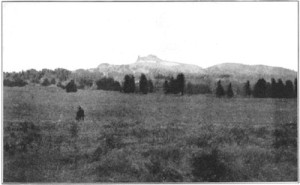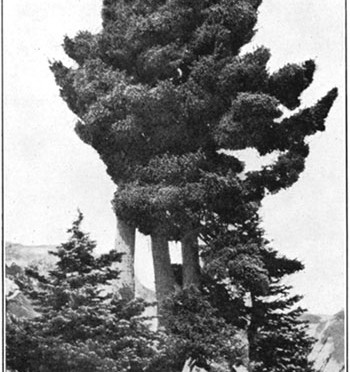Forests of Crater Lake National Park
Mountain Hemlock (Tsuga Mertensiana)
Besides alpine fir, there are two other timber line species, the mountain hemlock and white-bark pine, that climb to the highest, most rocky and wind-swept slopes throughout the Crater Lake National Park.
Mountain hemlock (Tsuga mertensiana) usually is a short, stunted tree, with a heavy body whose crown reaches nearly to the ground (figs. 17 and 18). In the forest it produces a clean, straight trunk, and narrow, sharp pointed crown, but when standing alone on crests and ridges, the trees are bent down and distorted, and the long, lower limbs spread far out over the ground. The leaders of terminal shoots always droop gracefully, and in the fall the entire slender tops of the trees bend under the weight of their heavy load of greenish-purple cones. These cones, when mature, are about 2 inches long, and their smooth scales open in late fall, liberating the seeds. The ground beneath mountain hemlock trees always is littered with many fallen cones, whose scales then become widely spread and deflexed. The color of the feathery foliage is blue-green, and the reddish-brown bark always is deeply furrowed and roughened.

Fig. 17—Mountain hemlock (Tsuga mertensiana)
Photograph by George O. Ceasar.
Mountain hemlock grows naturally in the high mountains, from Alaska to California, also in the northern portion of the Rocky Mountains. On account of its usual small size and high range it is not used commercially except occasionally for mine timbers.

Fig. 18—The Watchman. This sparse forest cover is typical of the higher altitudes in Crater Lake National Park. The timber is mostly mountain hemlock (Tsuga mertensiana).
Mountain hemlock is very abundant around the outer slopes of Mount Mazama for several miles below the rim. The road from Anna Spring to the lake passes through a heavy, nearly pure stand of this species, in which the trunks crowd each other for floor space beneath the shade of their heavy crowns.
Other pages in this section
*** previous title *** --- *** next title ***


